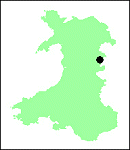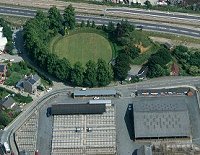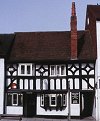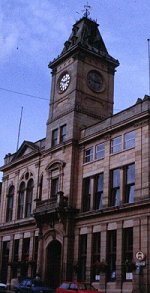
Cymraeg / English

|
Introduction |

|
Interactive map |

|
Surrounding area |

|
History of the town |

|
Index of sites |

Your Community - Welshpool
As part of our Regional Heritage Management Service funded by Cadw, and in conjunction with the Welshpool Partnership and the BBC Walk Through Time web pages for mid-Wales (linked to the TV series British Isles, A Natural History), the Clwyd-Powys Archaeological Trust have created an interactive map of Welshpool, Powys and various supporting web pages about the town and its surroundings. Visitors can interrogate the map and read about, and see photographs of, the sites, monuments, buildings and artefacts of archaeological and historical interest, and access background information. This information comes from the Regional Historic Environment Record (HER), a public-access database about archaeology and history curated by CPAT.
Please remember that while many of the sites discussed here are visible from public roads and footpaths most of them are private property, and this should be respected.
A brief history of Welshpool . . .

Location
Welshpool functions as a nodal point on the edge of the Severn Valley with three main roads intersecting here including two trunk roads, the A483 and the A458.
Set on the western slopes above the Severn flood plain at the point where the Nant-y-caws Brook (also described as the Lledan Brook) converges on the river, Welshpool's historic core is enveloped by 19th and 20th-century housing on the west, south and north, and by a lower-lying industrial zone to the east.
History
There have been various suggestions as to the derivation of the name Welshpool. Records of 1253-4 provide the earliest names for the town which refer to Capella de Trallu'g said to mean 'the chapel of pool town'. Later this name occurs as a latinised form of pool - Pola. The Pool in question has been taken to be either, a large sheet of water formerly in Powis Park, or alternatively a the part of the River Severn at nearby Pool Quay - the highest navigable point of the river in medieval times. In 1277 Edward I created Gruffyd ap Gwenwynwyn, Prince of Upper Powis and the owner of Powis Castle, Baron de la Pole. Leland is credited with the first reference to Welshpool around 1530, the welsh element apparently having been added by this time to distiguish it from Poole in Dorset.
Welshpool is said to have been the site of churches founded by St Cynfelyn and his brother Llywelyn in the 6th century. The location and nature of these churches and any accompanying settlement remains unknown.

Domen Gastell, a motte and bailey castle was thrown up closer to the flood plain, but at what date is uncertain. The earliest reference which seems to relate to this earthwork comes in 1196, but it is possible that it was constructed as early as 1111. It may have continued in use into the later 13th century, but at this time and possibly even earlier Powis Castle became the major stronghold in the neighbourhood. Thus, the reference to houses surrounding a castle at Welshpool being razed for defensive purposes unfortunately cannot be attributed to a specific fortification although it seems more likely that dwellings would have grown up around Domen Gastell than Powis Castle.

The borough of Welshpool may have been established by the Prince of Powys as early as the 1240s when the burgesses received a foundation charter. A market was recorded in 1252 and forty years later there were 106 taxpayers in the town, a total which had risen to 225 by 1322.
In 1253 a documentary record confirms two ecclesiastical buildings in the town (Ecclesia de Pola and Capella de Trallug).
The Glyndwr rebellion and the general decline apparent in many Welsh border towns in the 15th and 16th centuries, seem to have had a restricted effect on Welshpool, to judge from the picture of the town on an estate map of 1629. Leland termed it the best market in Powysland in the 1530s, replacing Montgomery as the regional centre because of its better location.

Although the wool trade had been the mainstay of Welshpool's economy since medieval times, the growth of the flannel industry during the late 18th century added fresh impetus to the development of the town, though it has been argued that it failed to become a predominant urban focus in Wales because of competition from towns higher up the Severn Valley. Certainly Welshpool did not see the same level of industrial growth as nearby Newtown, where some of Britain's earilest factories still survive, but the effects of this revitalisation can be seen in the many fine Georgian houses on Welshpool's main streets. The opening of the Montgomeryshire Canal in 1796 added considerably to Welshpool's importance, and the arrival of the Cambrian Railway in 1862 cememted the town's position as a regional centre. With various local government reorganisations in the early 20th century, Welshpool became the administrative centre of the County of Montgomeryshire, a postion it retained untill 1974, when the formation Powys (by amalgamating Montgomeryshire, Radnorshire and Brecknockshire) created a 'higher' tier of local government.
Buildings and Archaeology
The church of St Mary has a complicated architectural history. Haslam suggests it was refounded in c.1250 and that much of the tower dates from that century. The rest of the building appears to have been added to during nearly every subsequent century, and was restored twice in the Victorian era. Inside there is little that predates the 19th century.

A considerable number of the buildings in the centre of the town have been listed, invariably Grade II apart from St Mary's church which is the sole Grade I structure. Numbers 5 and 6 Mount Street are thought to be 15th-century timber-framed cottages, while The Mermaid, 1 Mount Street and 38 Mount Street are attributed to the 16th century. It is no coincidence that all of these lie at the top of the town away from the commercial centre where the demands for refurbishment are always likely to have been greater. In this respect the recent uncovering from beneath its later veneer of a timber-framed first-floor hall-house lying back from Broad Street in Hopkin's Passage is instructive.

Powis Castle, on the outskirts of the town, also has a Grade I listing and is surrounded by magnificent C17th gardens and later parkland.
A second-century Roman burial in the area of the Smithfield was discovered in 1959, and stray Roman coins have also come to light within the town.
The 'Old Church' lay at the junction of Mill Lane with Salop Road. Traditionally associated with Llywelyn's church, the building that was still standing as a ruin in the 18th century was erected in 1587, but badly damaged by fire in 1659. However, Capel Sainte Lleu'n which stood south of the present church and Salop Road was referred to in a will of 1545. The discovery of human remains in 1986 attests the presence of an adjacent graveyard.
Domen Gastell is a well-preserved motte, but the bailey has suffered from re-use as a bowling green.

St Mary's church is generally considered to have been founded with the borough in the 13th century. However, it lies on the opposite side of the Lledan Brook from the borough. Its position on a spur above a watercourse is typical of early medieval foundations and Soulsby has commented on the fact that an estate map of 1629 has the statement 'Welshe towne' printed adjacent to the church. The map also implies an oval churchyard - in contrast to the rectangular area today - but this could be no more than a stylistic device employed by the cartographer. Overall, a strong case can be made for this being an early church and by extension the earliest settlement at Welshpool should be in the Salop Road/Mill Lane area, previously favoured by the Romans.


The layout of the town is essentially linear with the main axis, Broad Street lying on the southern edge of the Lledan Valley. By 1629 both the town hall and the market house as well as the market cross were located in the centre of this thoroughfare. Several lanes run off Broad Street to north and south with a road intersection (now Berriew Street and Church Street) at its eastern end. Narrow burgage plots remain clearly defined on Broad Street and Berriew Street, and it is evident from the estate map of 1629 that at that time (and by implication in previous centuries) Broad Street was the main focus. A feature of this urban pattern is the numerous narrow alleys, many of them named, which ran off the main street.
The agricultural dimension to medieval and early post-medieval Welshpool is largely lost. Sub-divided fields once covered a substantial area of lower ground between the town and the Severn and are depicted as such on an estate map of 1663 but these have been almost completely erased by the modern industrial development. Depicted on the map was 'the Ould Field' near a later farm called Henfaes which is probably the earliest area of cultivation. Nevertheless, ridge and furrow cultivation has been recognised in various places, both in Powis Park and in the hills surrounding Welshpool and it may be that some of this is of medieval origin.
Powis Park contains other significant earthworks including an enclosure, just above the Oldford Estate, which is probably medieval, though it bears a passing similarity to a Roman military site.